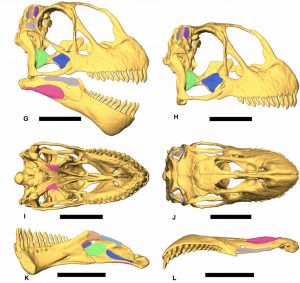
Sauropod dinosaurs are the biggest of all the wonderful behemoths to have ever roamed the Earth. Standing on four solid tree trunk legs, these giants are emblazoned in our hearts, minds and history books as towering Mesozoic monoliths, with long swooping necks, whiplash tails, fermentation-factory torsos, and weirdly tiny heads totally at odds with their immense bulk.
Many of these strange features sauropods possessed are underpinned by one key and unique aspect of sauropod life: how the hell did they eat enough to sustain such a massive body size? This question has had palaeontologists pondering for decades now, and is part of an ongoing puzzle that seeks to reveal how sauropods became some of the most diverse and abundant dinosaurs in spite of their sheer enormity.
Feeding is one of the most important ecological aspects to study for animals, as it influences their life style, metabolism, habitat, and general life strategy. Figuring this out for sauropods then is pretty important as it can tell us about how feeding links to evolutionary constraints on gigantic body sizes in land-dwelling animals.
Thankfully, computer-assisted engineering studies of biological organisms has really taken off in the last few years, especially in dinosaur studies. The field, generally known as biomechanics, applies our knowledge of materials and their physical properties to ask questions about how animals behaved in different ways, such as how fast they could run, or what bite forces they could achieve.
A team of researchers from the UK led by Dr. David Button decided to apply biomechanical methods to investigate the evolution of herbivory in sauropods and their ancestors, together called sauropodomorphs (palaeontologists win full points for originality..). To do this, they created 3-D computer models of the skulls two iconic dinosaurs, Plateosaurus from Europe, and Camarasaurus from North America. Sauropodomorph skulls are unusual in that despite being so small compared to their gargantuan bodies, they were highly specialised and effective cropping machines. But how this varied between different species is still relatively poorly understood.
What the team found then is that Camarasaurus had a much stronger bite force than the geologically older Plateosaurus. This was due to the former having greater chomping musculature – the adductor muscles – and also due to shape changes in the lower jaw, or mandible. By changing the jaw shape in particular ways, it is possible to increase bite efficiency by increasing the amount of muscle force that gets converted into bite force.
Woah, wait one second. Muscles? That’s crazy! We don’t have fossilised dinosaur muscles. Well, you’re right, we don’t (yet). But we do have skulls, and by comparing dinosaurs with other modern reptiles such as crocodiles and birds, we can actually be pretty confident about what the reconstructed skull muscles of dinosaurs looked like. By looking at both the reconstructed skull muscles and bones, Button and colleagues were able to gain a much more accurate mechanical picture of how sauropodomorph skulls function, as opposed to just using the skulls alone like the vast majority of previous studies.
This increase in bite force which they found on an evolutionary time scale is mirrored in the acquisition of additional key features that would have been critical in the ability of sauropods to bulk feed. For example, their tooth crowns became wider and were able to slide past, or occlude with, each other, making them much more efficient at cropping and slicing tough, fibrous plant matter.
In Plateosaurus, the jaw mechanics are quite different. The ability to distribute forces through the chewing gear and the structural strength appear to be much lesser in favour of being able to chew faster by opening and closing the jaws. This is due to features such as a relatively longer tooth row in Plateosaurus, which changes how the jaw operates as a mechanical ‘lever’.
Button and colleagues suggest that this could be due to Plateosaurus being at least partly omnivorous, as many other early sauropodomorphs might have been. This is because jaw closure speed isn’t exactly important when your sole ‘prey’ are, well, leaves, but is when your prey can try to run or wriggle away from you. In fact, Plateosaurus even has different types of teeth in the same individuals, a feature called ‘heterodonty’, that indicates the animals fed on different types of material, perhaps even small animals.
The shift from this structurally weaker skull in Plateosaurus to one in Camarasaurus that can accommodate increasing food-related forces would undoubtedly have been significant in sauropods’ increasing ability to bulk feed, and ultimately their enormous size as part of an ‘evolutionary cascade’.
Reference:
David J. Button et al. Comparative cranial myology and biomechanics ofandand evolution of the sauropod feeding apparatus, Palaeontology (2016). DOI: 10.1111/pala.12266
Note: The above post is reprinted from materials provided by Public Library of Science.










